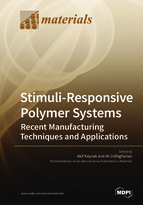Stimuli-Responsive Polymer Systems—Recent Manufacturing Techniques and Applications
A special issue of Materials (ISSN 1996-1944). This special issue belongs to the section "Manufacturing Processes and Systems".
Deadline for manuscript submissions: closed (15 April 2019) | Viewed by 34704
Special Issue Editors
Interests: conducting polymers; sensors; actuators
Special Issues, Collections and Topics in MDPI journals
Special Issues, Collections and Topics in MDPI journals
Special Issue Information
Dear Colleagues,
Stimuli-responsive polymer systems can be defined as functional materials that show physical or chemical property changes in response to external stimuli such as temperature, radiation, chemical agents, pH, mechanical stress, and electric and magnetic fields. Recent developments in manufacturing techniques facilitated production of different types of stimuli-responsive polymer systems such as micro and nanoscale structures with potential applications in soft sensors and actuators, smart textiles, soft robots and artificial muscles.
This Special Issue aims to focus on recent significant progress in manufacturing techniques and applications of stimuli-responsive polymer systems and will consider full research papers, communications, and review articles for publication. We would like to bring together a collection of comprehensive reviews from leading experts and up-to-date researches from notable groups in the community.
Suggested topics:
- Multiple-stimuli responsive polymers; shape memory polymers
- Elastomers; hydrogels; polyelectrolytes
- Electroactive polymers and gels; conjugated polymers
- Manufacturing of stimuli responsive polymer systems; 3D printing; lithography
- Modelling and control of responsive polymer sensors and actuators
- Self-folding polymers; origami, auxetic, or voxel structures
- Batteries, capacitors; electrochemical transistors
Dr. Akif Kaynak
Dr. Ali Zolfagharian
Guest Editors
Manuscript Submission Information
Manuscripts should be submitted online at www.mdpi.com by registering and logging in to this website. Once you are registered, click here to go to the submission form. Manuscripts can be submitted until the deadline. All submissions that pass pre-check are peer-reviewed. Accepted papers will be published continuously in the journal (as soon as accepted) and will be listed together on the special issue website. Research articles, review articles as well as short communications are invited. For planned papers, a title and short abstract (about 100 words) can be sent to the Editorial Office for announcement on this website.
Submitted manuscripts should not have been published previously, nor be under consideration for publication elsewhere (except conference proceedings papers). All manuscripts are thoroughly refereed through a single-blind peer-review process. A guide for authors and other relevant information for submission of manuscripts is available on the Instructions for Authors page. Materials is an international peer-reviewed open access semimonthly journal published by MDPI.
Please visit the Instructions for Authors page before submitting a manuscript. The Article Processing Charge (APC) for publication in this open access journal is 2600 CHF (Swiss Francs). Submitted papers should be well formatted and use good English. Authors may use MDPI's English editing service prior to publication or during author revisions.
Keywords
- Responsive polymers
- actuators
- sensors
- 3D printing








